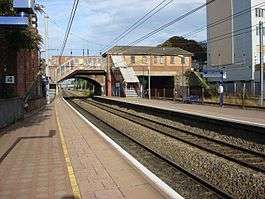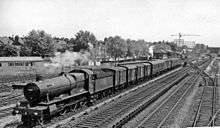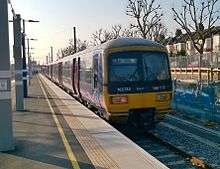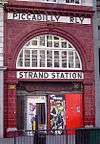West Ealing railway station
| West Ealing | |
|---|---|
 | |
 West Ealing Location of West Ealing in Greater London | |
| Location | West Ealing |
| Local authority | London Borough of Ealing |
| Grid reference | TQ166807 |
| Managed by | TfL Rail[1] |
| Station code | WEA |
| DfT category | E |
| Number of platforms | 3 |
| Fare zone | 3 |
| National Rail annual entry and exit | |
| 2012–13 |
|
| 2013–14 |
|
| 2014–15 |
|
| 2015–16 |
|
| 2016–17 |
|
| Railway companies | |
| Original company | Great Western Railway |
| Pre-grouping | Great Western Railway |
| Post-grouping | Great Western Railway |
| Key dates | |
| 4 June 1838 | Line opened |
| 1 March 1871 | Station opened as Castle Hill and Ealing Dene |
| 1 March 1883 | District Railway service introduced |
| 30 September 1885 | District Railway service ceased |
| 1 July 1899 | Renamed West Ealing |
| Other information | |
| Lists of stations | |
| External links | |
| WGS84 | 51°30′49″N 0°19′13″W / 51.5137°N 0.3203°WCoordinates: 51°30′49″N 0°19′13″W / 51.5137°N 0.3203°W |
|
| |
West Ealing railway station is on the Great Western Main Line in Ealing, west London. It is 6 miles 46 chains (10.6 km) down the line from London Paddington and is situated between Ealing Broadway to the east and Hanwell to the west. Its three-letter station code is WEA.
All main line trains serving it are currently operated by Great Western Railway and TfL Rail. In December 2018 the TfL Rail service will be re-branded as the Elizabeth line and in December 2019 the Elizabeth line service will open to Reading and Heathrow Airport.
History


The station was opened in 1871 as Castle Hill and Ealing Dene on the Great Western Railway, which was constructed from London Paddington through Ealing to Maidenhead in 1836–1838.[3] From 1 March 1883, the station—then named Castle Hill (Ealing Dean)—was served by District Railway services running between Mansion House and Windsor. This service was discontinued as uneconomic after 30 September 1885.[4][5] The station was located next to the London Co-operative Society's main creamery, and so was equipped with a dedicated milk train platform.
Originally the station consisted of four platforms in a staggered layout: platform 1 (along with a siding) and the island comprising platforms 2 and 3 to the west of the Drayton Green Road bridge, and platform 4 on the east side.[6] Platform 1 and its siding were demolished in the late 1960s; platform 4 was demolished and moved west of the bridge by early 1990, partially covering the site of the then long-closed milk depot;[7] platform 2 was partially demolished and fenced off by early 1991 as trains on the main line no longer serviced the station. From around 1985 to 1990, access to the original platform 4 was opposite the station building, across Drayton Green Road bridge. The current station building was completed in early 1987, following the demolition of the previous century-old building a year earlier. A west-facing terminating platform, platform 5, was added in 2016 for trains on the Greenford branch.
Accidents and incidents
On 5 August 1989, an express passenger train travelling from Oxford to Paddington collided with a piece of rail left on the track, probably by vandals, and the locomotive, Class 50 50025 Invincible, was derailed along the points near to platform 2 (these points were removed by November of that year). There were no serious injuries.[8][9]
Description

West Ealing is on the original line of the Great Western Railway. The restricted facilities are an intermittently open booking office and a ticket machine. The station is in Travelcard Zone 3.
Presently there are five lines (two for fast services out of Paddington), but only platforms 3–5 exist. There are also the remains of another platform next to platform 5, which is the now long-closed LCS dedicated milk depot platform.
Services
The station is served on Mondays to Saturdays by local services operated by Great Western Railway and TfL Rail. The station is closed on Sundays.
Timetable
The typical Monday-Saturday service frequency (trains per hour – tph) is:
- 4tph to London Paddington
- 2tph to Hayes & Harlington
- 2tph to Heathrow Terminal 4
- 2tph to Greenford
The majority of services are due to change to being operated by Crossrail in May 2018.
Since October 2008, Oyster "pay as you go" can be used for journeys originating or ending at West Ealing.[10]
In September 2016, Great Western Railway began operating services using EMUs, which led to some Greenford services that had previously run to Paddington to terminate at West Ealing using the newly converted terminal platform. All Greenford services terminate at West Ealing from January 2017.[11]
| Preceding station | Following station | |||
|---|---|---|---|---|
| Drayton Green | Great Western Railway Greenford Branch Line Monday – Saturday only |
Terminus | ||
| Hanwell or Southall towards Hayes & Harlington or Heathrow Terminal 4 |
TfL Rail Hayes & Harlington/Heathrow - Paddington Monday – Saturday only |
Ealing Broadway towards London Paddington | ||
| Future developments | ||||
| Preceding station | Following station | |||
towards Reading | Crossrail Elizabeth line | towards Shenfield |
||
| Historical services | ||||
| Preceding station | Following station | |||
towards Windsor | District line | towards Mansion House |
||
Connections
London Buses routes E7 and E11 serve the station.
Future
There are plans to provide through Crossrail services across central London at the station from autumn 2019.[12] As part of this proposal, services from the Greenford Branch Line will terminate at West Ealing. Network Rail is creating capacity for this by converting the former LCS milk train bay into an extra bay platform, which was completed in mid-2016.[13] In addition, various further alterations will be made by Network Rail by the end of 2017:[14]
- New station building with a larger ticket hall with level access from Manor Road (to the north of the station)
- Step-free access
- Platforms 3–4 extended to enable 9-car trains to stop
- Improved passenger facilities including increased lighting, a new canopy on platform 4, and information and security systems
References
- ↑ Station facilities for West Ealing
- 1 2 3 4 5 "Station usage estimates". Rail statistics. Office of Rail Regulation. Please note: Some methodology may vary year on year.
- ↑ MacDermot, E T (1927). History of the Great Western Railway. 1 (1833-1863) (1 ed.). London: Great Western Railway.
- ↑ Rose, Douglas (December 2007) [1980]. The London Underground: A Diagrammatic History (8th ed.). Harrow Weald: Capital Transport. ISBN 978-1-85414-315-0.
- ↑ Day, John R.; Reed, John (2008) [1963]. The Story of London's Underground (10th ed.). Harrow: Capital Transport. p. 26. ISBN 978-1-85414-316-7.
- ↑ Law, John. "glc - west ealing station gwr" on Flickr. Retrieved 24 November 2017.
- ↑ Mitchell, V; Smith, K (2000). Branch Lines of West London. Midhurst: Middleton Press. p. 4. ISBN 978-1-901706-50-5.
- ↑ "Photo of 50025 at West Ealing, August 1989". Rail Blue. Retrieved 15 March 2016.
- ↑ "Accident at West Ealing in August 1989". Railways Archive. Retrieved 13 November 2017.
- ↑ "Oyster PAYG on National Rail" (PDF). National Rail Enquiries. 20 October 2008. Archived from the original (PDF) on 19 April 2009.
- ↑ "Greenford line alterations". Great Western Railway. Archived from the original on 14 October 2016. Retrieved 14 October 2016.
- ↑ "Crossrail - West Ealing Station" www.crossrail.co.uk; Retrieved 21 March 2016
- ↑ Transport Watch: 'Tube crime down for third consecutive year' - Ealing Gazette
- ↑ "Crossrail Station Design Contract Awarded". Crossrail. 17 May 2011. Retrieved 13 May 2012.
External links
| Wikimedia Commons has media related to West Ealing railway station. |
- Train times and station information for West Ealing railway station from National Rail
